We left
Katherine in the apartment waiting for her friend Jess while we went to the
restaurant for breakfast. We used 2 trams and it made it a short slightly
downhill walk at the end. The menu we were offered was all English style (it is
close to the castle so tourist orientated) and we also got the extra keys. The
manager who had let us in yesterday was there and came over to say hi.
We looked at
the castle security queues and decided to go there tomorrow. The queues won’t
be shorter we suspect, but we will be better prepared. We did stop for photos
of the town which are always amazing from there.
Then we walked
in a different way down to the Charles Bridge. It took us past a church that
was the venue for concerts and had amazing metal faced doors, and a sidestep
had us at the Lennon wall. John had just
heard me refer to it and was thinking Lenin not John Lennon until I said a bit
more about it
The
Renaissance wall, a border of the Grand priority garden, is located opposite
the French embassy. In 1988 the wall was a source of irritation for the then
communist regime of Gustav Husak. Young Czechs would write grievances on the
wall and in a report of the time this led to a clash between hundreds of
students and security police on the nearby Charles Bridge. The movement these students
followed was described ironically as Lennonism and Czech authorities described
these people variously as alcoholics, mentally deranged, sociopathic, and
agents of Western capitalism.
The wall continuously undergoes change and the
original portrait of John Lennon is long lost under layers of new paints. Even
when the wall was re-painted by some authorities, on the second day it was
again full of poems and flowers. Today, the wall represents a symbol of youth
ideals such as love and peace.
It
seemed ironic that the area also seemed to be the base for a tour company using
vintage/expensive cars. We saw them at various places and also saw a group of
people in vintage clothes using them in another area.
All
walks in Prague seem to get you to the Charles Bridge, and this was no
exception. The weather was a bit better than last evening so the bridge was
busier, although not actually crowded. The hardest part to get past was an area
with a band playing and selling CDs. There were lots of artists on the bridge
and we would have had a choice of the usual caricatures silhouettes or quick
portraits if we had wanted them, which we didn’t. We went under it to add to our cache total.
After we crossed we walked slowly towards the area with the
Astronomical Clock.
Sadly, it is out of action at present, but the area was
still busy. There were dancing polar bears, people with various birds you could
hold and living statues. The hardest part is to take photos and not include
them, as otherwise you do need to pay. We had seen one living statue get really
cross after someone posed with him then just walked off. We took a picture at
the Meridian line for a cache and were amused to see that after we did, a lot
of other people also started taking photos. Prague,
use to use its own local time. To determine high noon, the city used a shadow
cast by a Marian column that fell directly upon the meridian of 14°25’17″ East
each day. This occurred from 1652 to 1918, from when the meridian was set into
the stones to when the Marian column was torn down by a mob in 1918 during a
demonstration against the Habsburg Monarchy.
We took a few photos of the imposing powder tower as we
approached. This monumental entrance by which the coronation processions of
Czech kings entered the Old Town is one of the most significant monuments of
Late Gothic Prague.
Completed in 1475, the Powder Tower, which formerly served
as a gunpowder store, is still the starting point for the Coronation or
Royal Route to Prague Castle. We might have gone up the Tower for the views on a nicer day.
We
got to the nearby Museum of Communism close to midday, although it was our
destination from the start, because we were happy to get side-tracked. I had
read the reviews which were mixed mainly because some people had not liked the
amount of reading involved. It was mainly a series of panels about the
progression of life under the communists until the fall of the Berlin Wall lead
to democracy being reinstated. However, there were also some visuals and
recordings from people who had lived through the times. We happily spent about
couple of hours there.
The
first thing you see is a statue of Karl Marx Other notable images were the
stamps based on Hitler’s photo at Prague castle taken in 1938 and photos of the
repatriation of Germans who had lived in the republic in 1945 with a swastika
on their backs. These were setting the scène for the communist popularity in
the early years.
There
were photos of an enormous statue that used to be here showing Stalin with a
group of citizens behind him. It was 22m long, 16m tall and took 3 years to
build in pinkish granite, and cost a fortune to build. Even at the time, the
locals were not fond of it, and jokingly referred to it as the line for meat.
It was demolished 7 years later when Khrushchev took over in the Soviet Union.
When it was demolished no one was allowed to take photos but there were massive
explosions in Prague for a week.
The
photos of the apartment blocks also hit home. Our guide in Cesky Krumlov talked
of the ugly blocks. The ones in Prague were huge. Also huge were the
Spartakiade (mass gymnastic) events. They took place at the Strahov Stadium, the largest stadium ever
built and were held every 5 years from 1955 except in 1970 in the wake of the
Prague Spring. Preparations for the Spartakiad scheduled for 1990 were
interrupted by the Velvet Revolution but the event still took place, although
on a much smaller scale than the previous ones. They were attended by large
numbers of people; for example, at the 1960 Spartakiad about 750,000 gymnasts
from the whole country took part and over 2,000,000 spectators witnessed the
event. Men and women of all ages practiced their exercising routines for the
event. Appearance was originally mandatory for students and servicemen of the
armed forces and police. Huge amounts of money were poured into them, including
money to put food into stores so they looked full to outsiders.
With
all private businesses, including one person operations, nationalised, a
thriving grey economy developed. Construction workers, butchers, grocers etc
became the new elite. There was a popular saying – ‘He who doesn’t steal robs
from his family.’
There
was huge fear of nuclear conflict. Civil defence material also talked of the threat
of fatal diseases being introduce, and water contamination.
5500 fallout
shelters were built and children trained using gas masks. The fall out shelter
built under Wenceslas Square had three floors – a water tank on one, a hospital
on the second and a luxurious 250 bed capacity third floor for the top Warsaw
Pact people.
Finally,
the Prague Spring and then the Velvet Revolution were detailed The Prague
Spring was a
period of political liberalization in Czechoslovakia, It began
on 5 January 1968, when Alexander Dubček was elected leader of
the Communist Party of Czechoslovakia, and continued until 21 August 1968 when
the Soviet Union and other members of the Warsaw Pact invaded
the country to halt the reforms. Half a million Warsaw Pact troops and
tanks were sent to occupy the country. A spirited non-violent resistance
was mounted throughout the country, involving painting over and turning street
signs (on one occasion an entire invasion force from Poland was routed back out
of the country after a day's wandering),defiance of various
curfews, etc. While the Soviet military had predicted that it would take four
days to subdue the country, the resistance held out for eight months and was
only circumvented by diplomatic stratagems (see below). There were sporadic
acts of violence and several suicides by self-immolation (such as that
of Jan Palach which was detailed), but there was no military resistance.
Czechoslovakia
remained Soviet-controlled until 1989, when the Velvet Revolution ended
Soviet control.
This was a peaceful change of leadership that happened over 10
days. The role of students was emphasized as it was students from the
University of Prague that lead the protests.
We
emerged from the museum to a grey day and found a spot for lunch. We feel we
paid for all the heating in the restaurant with the cost of the meal, but did
appreciate our heater, if not the price. It goes with being in the Main Square.
I
then joined Katherine and Jess on a free walking tour, while John made his way
back to the apartment. He had one issue as he misplaced his tram ticket so had
a bit of a walk first.
Our
guide was English but had lived in Prague for a few years and taught English as
his day job. He gave us an overview of Czech history as well as pointing out
key places in Prague and handing on tips for visitors. He said there had been
people living in the area since 500BC
He told us the story of Libuse, who was Queen of
the Czech people in the 8th century, with a gift of foresight. Legend says that
Libuše came out on a rocky cliff high above the Vltava and prophesied: "I
see a great city whose glory will touch the stars." On the site she
ordered that a castle be built and a town created called Prague. Although she
proved herself as a wise chieftain, the men of the tribe demanded that she
marry, but she had fallen in love with a ploughman. She therefore related a
vision in which she saw a farmer with one broken sandal, ploughing a field, or
in other versions of the legend, eating from an iron table.
She instructed her
councilmen to seek out this man by letting a horse loose at a junction; they
followed it to the village of Stadice and found Přemysl exactly as she had said
(either ploughing a field, or using an iron plough as a makeshift table). They married
and he became ruler.
In the main square, the old town hall with some war
damage was pointed out with mention made of the astronomical clock, the oldest
still in operation (usually) and dating from 1410. We were shown the main
square features and the range of architectural styles including the Gothic Church
of Our Lady before Týn which has been the main church of this part of the city
since the 14th century, and the Baroque St. Nicholas Church.
The square's centre has a statue of religious
reformer Jan Hus, who was burned for his beliefs at the stake in Constance. Our
guide called him the first of the ‘Protestants’ (pre Martin Luther) as his
objection was to the wealth of the Catholic Church. The statue was erected on July
6, 1915 to mark the 500th anniversary of his death.
In front of the Old Town Hall at a place we could
not access is also a memorial to martyrs. 24 were aristocratic enough to be
beheaded and the other 3 were merely hung. They were also
reformists killed by the Habsburgs. Twenty-seven crosses mark the pavement in
their honour, installed during the repairs of Old Town Hall after WW2, while a
nearby plaque lists the names of all 27 victims.
We moved to a spot where there was a good view of the Castle and
we were told about the Royal Route. The Czech kings on their way to being
crowned would start at the Royal Court, which no longer exists, but was the
area where the Museum of Communism is. The procession would go to the old main square
then over the Charles Bridge and up to the Castle and finish at St Vitus
Cathedral.
Charles IV was mentioned a lot. He was born Wenceslaus but had
his name changed by the French King when he was studying there, we were told,
although I did later hear it was his choice in honour of his uncle who has the
French King. He rebuilt Prague on the model of Paris, establishing the New
Town, the first University in Central Europe (still named after him) and Prague
became the centre of the Holy Roman Empire. It was known as the Golden
Age of Bohemia.
We were introduced to a new word, defenestration, the act of
throwing someone or something out of a window. The first occurrence in Prague
was in 1419 when the Hussite reformers threw members of the council out the
Town Hall window and triggered a war between the Hussite, who were most of the
Czech population, and the Holy Roman empire.
The next time was when three were
thrown and either were saved by angels or because they fell in horse poo that
softened their fall. It triggered another war and some of the reformists who lost
were the ones in the 27 cross memorial.
The Jewish area was on the tour route, but just to hear about it
and see sights from outside with the recommendation of visiting ourselves. The cemetery
was pointed out as holding over 200 000 bodies in a small plot of land that has
been built up over time with bodies on about 12 layers as well as close together.
It is next to the Pink Synagogue. We were told that the area was not destroyed
by the Nazis under Hitler’s orders. He had intended it as a museum to an extinct
race. This was something we all heard
with disbelief and discussed later when we were all back at the apartment with
John.
I left Katherine and Jess in the city and went back by tram
after finding a cache. We were full after lunch so bought deli food from
Kaufmanns and had that for tea. We chatted with Katherine and Jess about our
days, made vague plans for the next and went to bed. Blogging was now getting
behind.

 Prague, Prague, Czech Republic
Prague, Prague, Czech Republic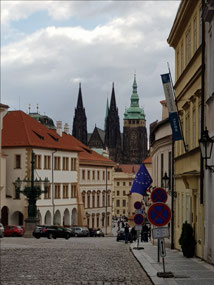
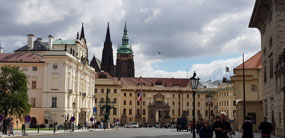
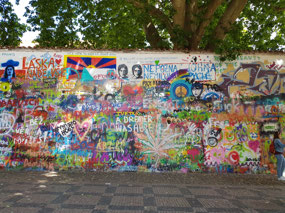
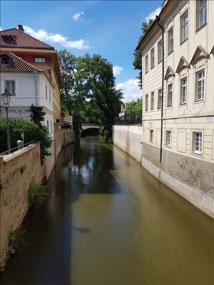
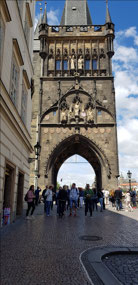
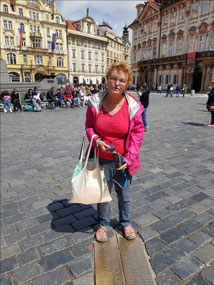
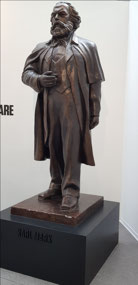
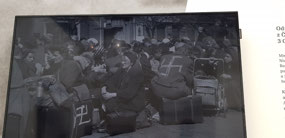
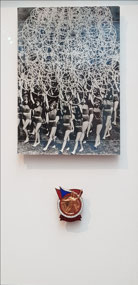
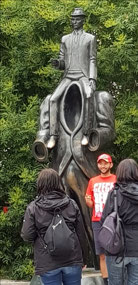






2025-05-22